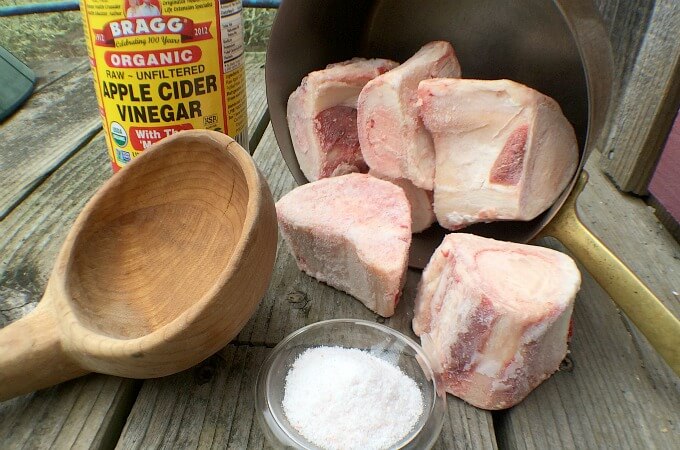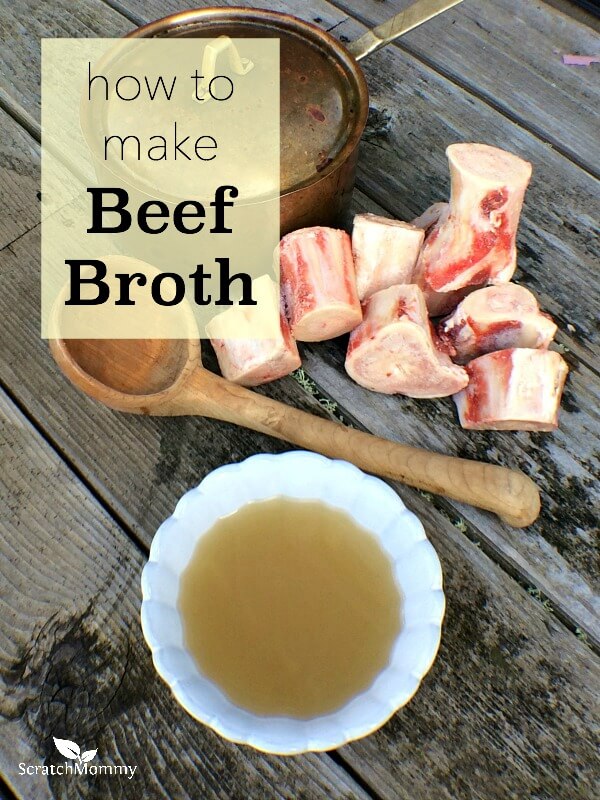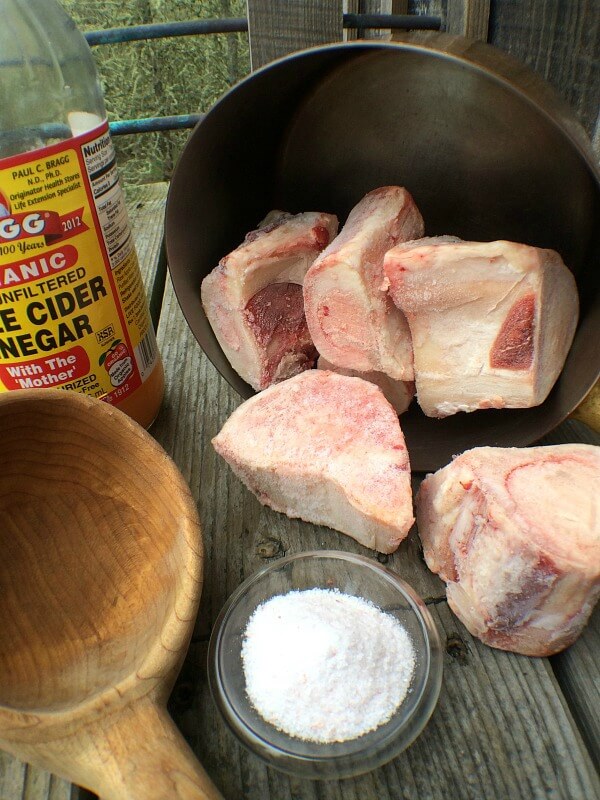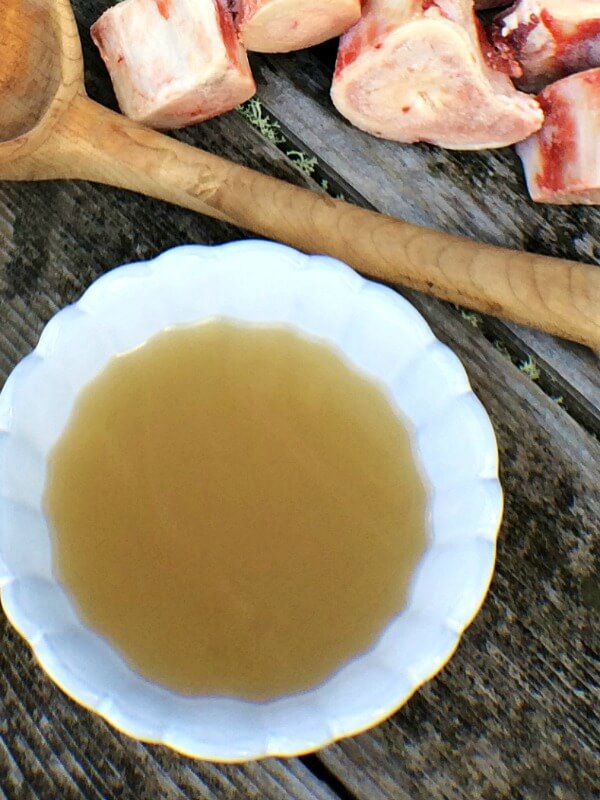Mineral, collagen, and gelatin-rich bone broth is catching on. Its health benefits are irrefutable; and the gentle nutrition it provides is now being recommended by health practitioners in every field.
My family and I own three gut-healing cafes and bone broth is our specialty. From Paleo customers to cancer patients, our quarts of frozen bone broth are in high demand. Our provision of this product fills us with joy; work is a pleasure when you can meet someone’s needs toward wellness.
I personally started drinking bone broth over 4 years ago when I started a healing diet called GAPS to remedy some health concerns in our home, autoimmune diseases in my daughter and me. I have gained insight over the years about how to make the most nutrient-dense bone broth and I’m excited to pass the techniques along to you.
Beef broth is my favorite! Its rich, hearty flavor is a comforting way to start the day. As odd as it may sound, I love beef broth in a mug first thing in the morning.
To make the most nourishing beef bone broth, I am going to share a little known must: harvest your bones’ broth at least two times: once after 2-3 hours for a very healing, high-fat broth, once after 24 hours, and again, optionally, between 48 and 72 hours.
This tip is not only economical and delicious, as each of the bones’ harvests have a different flavor profile and you get more broth for your bones, the nutritional benefits derived are well worth honoring.
Dr. Natasha Campbell-McBride is not a household name for most newbies to bone broth. But for those of us on healing diets her guidelines are gold. Dr. Natasha created a diet, (GAPS), that helps to heal many modern health epidemics, not the least of which is autism, in part by teaching the practice of drinking bone broth three times a day, with meals.
Understanding the chemistry of food, she enlightened my own experience: if high-fat broth boils for too long it becomes rancid. I had tasted this unpalatable flavor but didn’t know the cause until reading her book.
While bone broth does indeed cook for a minimum of 24 hours for a certain kind of broth rich with minerals, the first yield of broth is actually highly nutritious, full of gelatin and healing fat.
Harvesting the first fat can proceed in one of two ways: the cook can either carefully skim off all fat and reserve it for cooking purposes (do not discard) or the entire first batch of broth can be poured or ladled from the bones and used or stored.
Each time you gather the broth from the bones, you simply add more water and sea salt, and keep going. If you’re using a crock-pot the whole process is easy and mess-free.
For healing the gut, restoring good general health, reducing inflammation, fighting viruses, and a host of other benefits, bone broth is the most healthful tonic of all.
Below you’ll find how to make beef broth that tastes delicious!
- 1.5 lbs. beef bones (grass-fed), exposed marrow bones or joints preferred (use Home Grown Cow to find beef bones in your area)
- 2 Tbl raw apple cider vinegar, optional (not ideal or necessary for those with FODMAP or fructose sensitivities)
- Filtered water
- 1 Tbl + 2 tsp unrefined sea salt, (adjust according to pot size and to taste)
- Add bones to crock-pot.
- Fill with filtered water.
- Add apple cider vinegar and sea salt.
- Once the water is simmering or very hot, cook for 2-3 hours.
- Harvest all fat, or fatty broth, for a healing tonic.
- Add new water, salt, and apple cider vinegar and simmer on low at least 24 hours and up to 72 hours.
- Strain and use.
I blog over at Eat Beautiful and my post on How to Make Bone Broth has elicited many questions. Perhaps the most popular query received, in addition to the surprise I get about the first 2-3 hour harvest, is whether or not to add vegetables, herbs or spices to the bone broth while it’s cooking.
My recipe and approach do not contain vegetables for a few reasons:
- Vegetables taint the overall flavor of the broth. They simply do not add to the yummy factor. Overcooked carrots, celery, parsley etc. make the bone broth taste unpleasant.
- Bone broth is a healing tonic. It is perfect and does not need added nutrition from well-cooked vegetables. The purpose of bone broth is to heal the gut lining. Cooked vegetables do not help to heal the gut lining.
- Making soup, with bone broth as the base, should indeed include vegetables. But the veggies should not be part of the bones’ boiling process. They are added afterwards per the instructions in a soup recipe.
- Herbs and spices are also unnecessary. Bone broth, flavor-wise, is delicious and perfect. Anything added beyond sea salt (and the optional apple cider vinegar) is a detraction. High-fat beef broth is one of life’s greatest food pleasures. Leave it be and let it speak for itself.





Comments 36
I find roasting the bones until they are a nice brown color before simmering in the water really deepens the flavor of the broth. Yum. And them I pour off the fat from the roasting pan and have tallow.
Author
Sounds lovely, Kate! I like your easy technique for getting the tallow too!
I am on a mission to heal my spleen and improve overall health.
Author
Good for you, Nellie! That’s wonderful. Bone broth will surely help!
I have been really researching bone broth and the trouble I am running into it the water evaporating and hardly anything left by the end of 2 days. I am not boiling it. I have it on really low so it either evaporates all out or the broth just kind of sits and does nothing. Also the smell. Do you find it really overwhelming for your home. I can’t have anyone over cause it is so powerful.
Author
Hi Vanessa, great questions. Firstly, regarding the smell- I have lots of clients who end up putting their crock pots in their attached garages! This is an excellent solution- easily accessible but it doesn’t smell up the house. Personally I love the smell; but I understand that many people do not. Regarding the water level, all you need to do is to add more water as needed. Each night I leave a crock pot on low. In the morning we drink mugs of broth or make soup; then I add more water, and salt if needed; (the flavor will indicate if it needs more salt and will be based on how much water has evaporated). If it is at a lower-fat stage then I leave it on high overnight and it needs way MORE water in the morning (but usually no more salt), accordingly. Please let me know if this fully answers your questions or if I can be clearer on any point. Cheers!
Hello so I’m wanting to make bone broth for my special needs baby but he cannot have a lot of sodium can i just make this with bones water and vinegar ? He has a G-Tube so I’m not worried about him liking it I just want to heal his gut as much as possible
Yes, you sure can. 🙂
Is it possible to can the broth for later use?
Author
It is, yes. But I am not experienced with it. We freeze ours if we have an abundance. Thanks for the question!
This was by far the best tasting recipe I have tried so far. For an extra health benefit I add 3 Tbsp. of Nutritional Yeast flakes to my morning cup of broth to get my B-V. MY favorite tasting brand is KAL ~
Author
Thanks for letting me know. I am warmed to the heart! It’s fun to hear about your variation and its nutritional benefits. Best.
I just saw this yesterday through Traditional Cooking School’s facebook page. I’m trying it now and WOW was my lunch serving excellent. You are right it does not need the veggies. Thank you for your timely info.
So glad to hear this Brenda. Thank you for your feedback after making it! 🙂
We are fortunate to have grass fed bison available and this is how I make my broth too! Ohh it is such a soul lifting joyful thing to make a good bone broth.
I agree!! So life-giving and lovely. Your grass-fed bison bones sound great!!
I’ve been making broth for several years, but for the past few months it seems like every other batch tastes off, maybe burnt in someway. Any idea what is causing this? I run the crock pot on low for 2 days. Is the crockpot breaking down and doing something weird? I’ve tried ignoring the taste thinking maybe it’s just me thinking it’s off, but it flavors rice and soup in such a way that no one wants to eat it.
Author
Are you harvesting that first batch after 2-3 hours? Even on low after that point will make the broth taste burnt or rancid. Perhaps you have become more sensitive and now notice?
Leaving the crock pot on over night scares me, I wouldn’t sleep worrying it might catch fire. 🙁
Thanks for sharing . I am wondering, due to histamine issues I am only able to use the 2-3 hour broth . Can I get a second use out of the bones or should I start with fresh bones every time I make the 2-3 hour broth ? Thanks .
Author
In your situation it is best to start with new bones. Thanks for the question. 🙂
Hi Megan – I love this post! I also do not add vegetables or herbs in when I am making broth. Some years ago when I started making broth I did this, but over time I began to realize that since we use broth for so many purposes, I wanted something generic that I could add in specific, fresh ingredients that fit in with particular recipes. So, if I wanted to make a curry soup, I would not start off with a curry broth. I’d begin with a generic broth that I’d already made, put it in the pot and then add my specific ingredients for curry. I agree that the flavor of vegetables that have sat for a day or longer is unappealing. Thank you for sharing this, it’s great information and it’s fun to know I’m not the only one who discovered this idea! 🙂
Author
Thanks, Raine, for your comment and kind words! Really fun to hear your experience and conclusions!!
I used to use a crock pot all The time as well but I found out that they lead sled it into your food and I have not found a leadfree source has anyone ?????
Author
If you scroll to the bottom of this post I discuss this issue and why I believe crock pots are safe to use. Thanks for the question! 🙂 http://eatbeautiful.net/2014/07/23/megs-bone-broth/
Do you have specific uses for the the different broths harvested at different times? What is the 2-3 hour broth best for? What about the next harvest? Sounds like a lovely recipe, I plan to try this out very soon!
Author
Yes, thanks Diana for your question. While all of the batches are versatile and can be used interchangeably it is true that they have personalities, so to speak, and fill certain roles best. The 2-3 hour broth is high fat and high flavor. I LOVE fat so I enjoy drinking it from a mug or poaching eggs in it, eggs with runny yolks, for breakfast. However, I know most folks don’t love fat as much as I do. So for most people the best thing to do with the first batch of broth is to make bisque. Take cooked veggies that you like well– especially onions, carrots, peppers and zucchini and puree them with slightly cooled broth until smooth. The fat will no longer be noticeable but the flavor and texture will be lovely. The following harvests are universally versatile for drinking plain, using for soups, bisques and in recipes, even smoothies (as the liquid– no one will know!). Cheers!
Can I use a Pressure Cooker instead of a Crock Pot? How long would I cook the bones under pressure?
Author
This is not my area of expertise so here’s a great guide on the process using a pressure cooker. You don’t need to follow her recipe, as far as adding the veggies and other ingredients she mentions. But the recipe tells you what pressure and for how long etc. 🙂 http://www.foodrenegade.com/pressure-cooker-bone-broth/
I have been viewing your post on the bone broth. Do you use other bones besides beef? What type of beef bones do you prefer to use? My local butcher has scrap bones that he has left over from butchering beef. I usually get them for my dogs, but was thinking that I might also be able to use them for bone broth. I would be interested in doing the broth on a daily basis. Would you recommend that I take the first issue after 2-3 hours out of the crock pot and then add more water and continue the cooking process to have available broth. Your statements seem to indicate that you are cooking bone broth on a daily basis.
Author
Hi Pat. Yes, you can use any animal bones, the only stipulation being that they should be organic and grass-fed, or from a local farmer who has these same high standards. I love beef marrow bones and chicken feet the best, for making broth. Any bones your butcher can provide will make good broth, though. Yes, you are right; we perpetually make broth. Our crock pot is always on. Yes, take the first “issue” or harvest after 2-3 hours; then add new water and sea salt and keep the bones going. Once there is no fat you can even boil the bones on high to get the most flavor and minerals from them. Cheers! 🙂
I like the idea of roasting them first for more flavor. Been years since I have seen chicken feet. lol No idea where to get them since most chicken in most stores is prepackaged and not sure if the local processing plant does them. My research has indicated that the longer they are cooked the more marrow and gelatin is released which provides the most benefit.
Yes, this is true! A 24-72 hour bone broth yields a rich content of minerals, gelatin and collagen that are released from the bones during the longer cooking time. The surprising news shared with us by Dr. Natasha Campbell-McBride in her Gut and Psychology Syndrome is that the first 2-3 hour broth is also highly nutritious– being high in healing fat and gelatin.
Regarding sourcing for chicken feet, it is best to get these from a local, sustainable chicken farmer or from a local, natural foods market. You do want to make sure the chickens they are harvested from were pastured or organic chickens. The sourcing is more important than what part of the animal the bones come from. 🙂 Hope this helps.
Hi Megan,
Thank you so much for this. We have been using your triple-harvest method since starting GAPS in December. Wonderful way to get the most from our bones, and so much more economical, too!
We now own an instant pot. Do you know where I can get info on the timing to do a triple-harvest batch in a pressure cooker?
Thanks, Alissa
Hi Alissa! I have been loving the stocks coming out of my Instant Pot! I do 30 minute auto increments, typically 2-3 times. I hope this helps. 🙂
Yes, that’s what I do too! 30 minutes for the first batch, and 4 hours for the 24-72 hour broth.